Editor’s note: This narrative was first presented by then MCPOCG Vince Patton as a eulogy for MCPOCG #1, Charles L. Calhoun, at Calhoun’s funeral service in Berlin, Maryland.
Charles Luther Calhoun, the son of a barber, Edwin, and a schoolteacher, Helen P. Calhoun, was born in Ocean City, Maryland, April 20, 1925. Raised a block away from the ocean, Charlie, or “Coonie” as many of his hometown friends called him, soon developed the age-old connection with the sea that marks a person as a sailor early in life. His grandfather was a commercial fisherman on the Maryland coast and taught Charlie his trade.
Calhoun volunteered to serve his country with the U.S. Navy in 1943 at the age of 17. He was a young man looking for action and a way to serve his country during World War II. Trained as a torpedoman, Calhoun served on the jeep aircraft carrier USS Lunga Point in the South Pacific, experiencing first-hand the toughest battles fought in that theater of the war: Leyte Gulf, Luzon, Iwo Jima, and Okinawa.
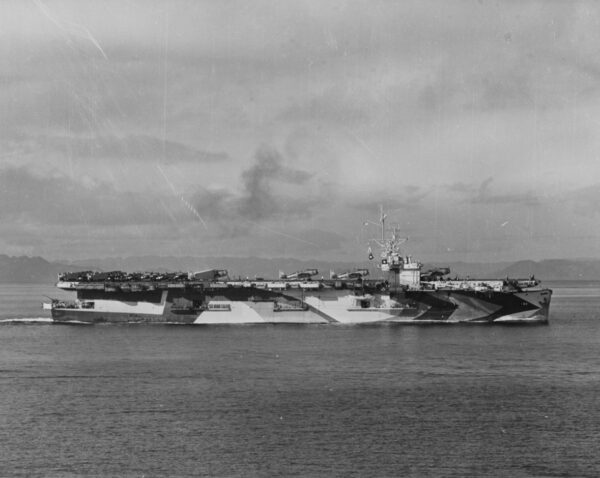
Toward the end of the war in the Pacific Calhoun faced the most lethal combat of his short naval career. While working out of Okinawa, the Lunga Point was attacked by a squadron of five kamikazes, Japan’s last desperate weapons against the American fleet. Calhoun was manning one of the carrier’s 44-millimeter guns when the attack began. When the last gun ceased firing, all five of the attackers had been destroyed, but not before the ship suffered two hits from one suicide plane. As the pilot had made his dive through the curtain of machine gun fire, the plane crashed first into the carrier’s island, and then rebounded onto the flight deck. The carrier’s flight deck was put out of commission, but the ship reached port under her own power. The crew of the USS Lunga Point received the Presidential Unit Commendation Award for “extraordinary heroism and action against enemy Japanese forces in the air, ashore, and afloat.”
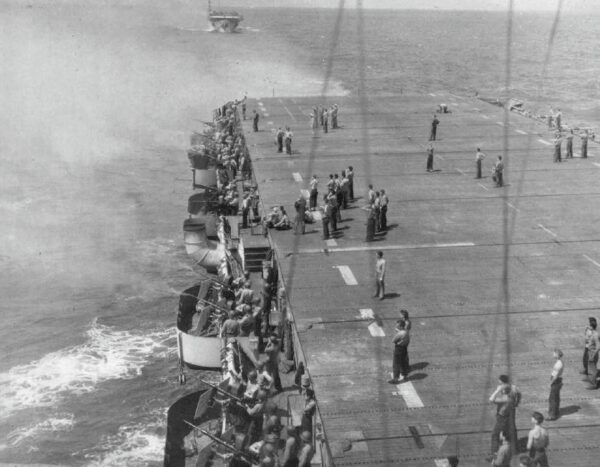
Torpedoman Second Class Calhoun decided he had enough excitement during his brief Navy career and was honorably discharged on February 21, 1946. After returning home to Ocean City, he worked a short time for the post office. It was there that he first discussed the Coast Guard with a friend who was planning to enlist. The two friends joined the service together on September 20, 1946. Because of his Navy experience, Calhoun was able to enlist as a Boatswain’s Mate Second Class.
Calhoun’s first Coast Guard assignment was in his hometown at the small boat station in Ocean City. While standing watch in the station’s lookout tower one stormy October night in 1947, Calhoun saw a man fall from one of the town’s jetties into the sea. After alerting the station’s other crewmembers, he raced down to the jetty and found the man clinging to the wet stones. The victim had broken his hip during the fall and could not pull himself to safety. Calhoun was able to lift the man from the water and stayed with him until an ambulance arrived. The Commandant at that time, Admiral Joseph Farley, personally presented Boatswain’s Mate Second Class Charles Calhoun with the Coast Guard Commandant’s Letter of Commendation for his single-handed rescue.
Not long after this rescue, Charlie Calhoun took another “plunge.” On May 29, 1948, he married Mary Alyce Bunting, also from the Ocean City Area. The two had met after Calhoun entered the Coast Guard and returned to his hometown after his discharge from the Navy.
Further into Charlie’s career he was once again sent into combat. During the Vietnam War he served aboard the USCGC Point Orient. The Coast Guard’s 82-foot cutters were an essential part of Naval Squadron One, responsible for patrolling the enemy coast. On the Point Orient’s first patrol she sighted and exchanged fire with an enemy company of soldiers on the beach. This action earned Calhoun’s crew the distinction of being the first Coast Guard cutter to fire a shot in that war. The members of Squadron One earned the Navy Unit Commendation Award for their part in minimizing enemy coastal movement and shipments.
It was during Master Chief Calhoun’s tour as Senior Career Counselor at the Fifth District Headquarters that he learned of the creation of the Master Chief Petty Officer of the Coast Guard office. With the encouragement of his peers and his wife, Mary, he submitted his application.
‘Standing The Watch’
Reflecting back on the atmosphere in the enlisted ranks at the time he began his tour as the Coast Guard’s Senior Enlisted member, Charlie remembered the overall feeling of frustration at the lack of communication, or “voice,” in matters that affected every sailor in the field. He made this attitude of frustration the main theme of the essay he wrote to accompany his application for the senior enlisted position. In it he outlined what he believed should be the main goals of the new office in order to alleviate the greater concerns of the enlisted force. Uppermost of these goals were: establishing a direct link with the enlisted personnel to hear their problems firsthand; receiving, reviewing, and initiating action on legitimate problems that personnel had; and the office having no other assigned duties but to look after the well-being of the Coast Guard enlisted workforce.
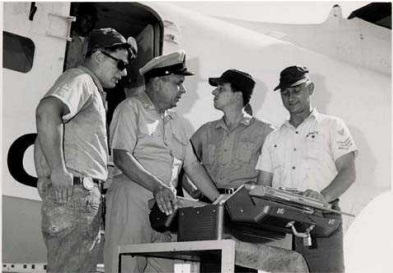
On August 27, 1969, in a somewhat quiet yet monumental moment in our service’s history, Charles Luther Calhoun stood before Admiral Willard Smith, who was the Commandant at that time and “assumed the watch” as the first Master Chief Petty Officer of the Coast Guard.
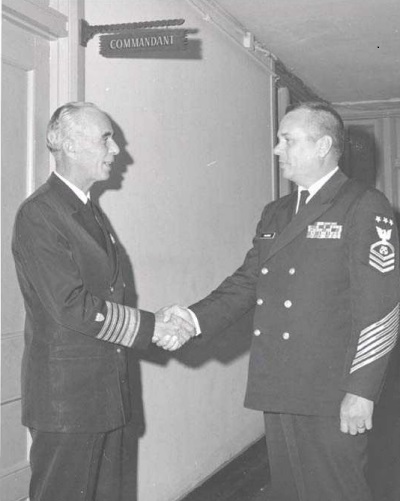
Retired Rear Admiral William Stewart, who was a Captain at the time and served as Admiral Smith’s executive assistant in 1969, was given the task of settling the new senior enlisted member into his office and “introducing the Master Chief to the Headquarters staff and the Headquarters staff to him.” Due to the attitude of some of the senior officers, those who had voiced their objections to the Commandant earlier, this could not have been an easy task. But Stewart remembers how Calhoun’s attitude and personality made the job fun,
“…Charlie was a crusty old Master Chief Boatswain’s Mate who was more at home on the starboard wing of the bridge than behind a large mahogany desk, but he was smart, articulate and flexible…”
One of the first things Master Chief Calhoun did was select the yeoman to become his one-man staff. He chose Yeoman First Class Bill Timmons, who held the job for two years before being promoted to Chief Petty Officer and transferring to another assignment. Calhoun’s second staff member was Yeoman First Class Harold Cathey. Both Timmons and Cathey retired from active service as master chiefs. This is a testament of Calhoun’s inspiration as a leader, motivator, and mentor to those who served under him.
Thinking back, Calhoun recalls that without the tireless efforts of these two men managing his phone calls, correspondence, mail, dealing with the constant flow of visitors to his office, scheduling and planning out the many trips to the field, and continually fighting the non-stop battle with paperwork, he would not have been able to do his job.
In the summer of 1970 Admiral Chester Bender succeeded Admiral Smith as Commandant of the Coast Guard. Master Chief Calhoun and his new boss learned each other’s ways and soon formed both a solid working relationship and a strong friendship. Calhoun continued to serve in his position for three more years under Admiral Bender.
Leaving His Legacy
The seven previous Master Chief Petty Officers of the Coast Guard before me, achieved their own impressive list of accomplishments by the end of their respective tours. Charlie Calhoun was no exception. In addition to the following list of deeds, and also the underlying factor for each, was the one undeniable fact that Calhoun was greatly successful in laying a strong keel upon which those who followed him built and continue to build on his legacy.
This exemplar performer made his presence felt at the numerous conferences and functions he was asked to attend. As the flag officers and their staffs grew accustomed to his presence, they also began to listen to his suggestions and advice. Through Calhoun’s efforts, these people slowly realized that the Master Chief Petty Officer of the Coast Guard office was not created to “steal their thunder,” but to assist them in their jobs by providing a much-needed perspective and knowledgeable voice.
During his watch, Calhoun was instrumental in restructuring the enlisted assignment system. At the time, all assignments were handled at the district level. Having many different district offices trying to communicate between each other to organize these transfers was time consuming and often confusing, especially to the member awaiting orders. Master Chief Calhoun helped push the decision through to take this responsibility away from the individual districts and create a centralized office at headquarters to handle all transfers. These efforts led to the establishment of today’s Coast Guard Personnel Service Command in Washington, D.C.
When the idea for the creation of a Cutterman’s Pin was announced and a board organized to work towards this goal, Calhoun was asked to participate. The result was a distinguishing insignia that Coasties have worn for 30 years designating them as the sailors of cutters and the keepers of the traditions of the Revenue Cutter Service, the Coast Guard’s predecessor.

Also, Calhoun is also credited with establishing a senior enlisted advisors’ program to bridge the communication gaps between his office and the field units, and by providing a regional advocate for personnel closer to their operating area who could listen and respond to their issues and concerns, or handle situations at the lowest level possible. When necessary, these senior enlisted advisors would have a direct link to the Master Chief Petty Officer of the Coast Guard, thus a closer connection to our service’s senior management level. These duties were assigned as collateral duties where the advisors, in addition to their primary specialty responsibilities, would work in this position in tandem with their regular tasks. It became the foundation to where today, the Coast Guard’s Command Master Chief program serves as the communications link up and down the chain of command, and as specialized fulltime ‘change agents’ for the organization, who provide the detailed explanations of what’s going on in the Coast Guard, problem solvers in conflict resolutions, and trouble-shooters in organizational management matters.
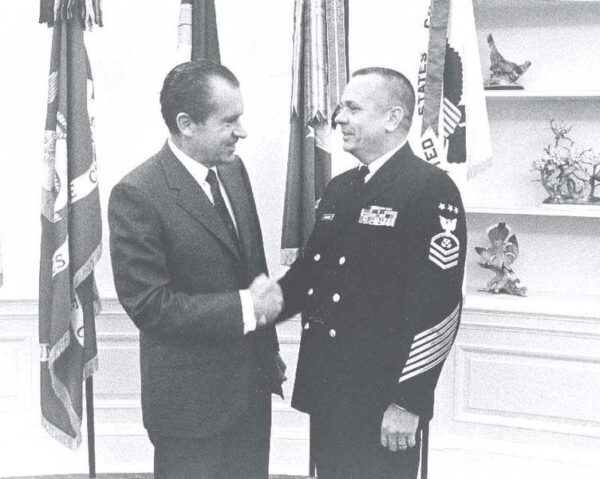
Most importantly, during his watch, he championed the need for our service to be more distinctive in appearance, thus breaking away from the tradition of where we once wore the U.S. Navy uniform, which only had small distinguishing marks such as the Coast Guard shield on the right sleeve, and the anchor and shields on the officer and chiefs’ uniforms. Reaching back into our Coast Guard past, where members of the U.S. Lifesaving Service wore a distinctive uniform, the service began its transition to what we all now wear today, known as “The Bender Blues.” At Calhoun’s retirement, he proudly wore his new Coast Guard “Bender Blue” uniform, fashioning it as a ‘new beginning’ in raising the visibility of the Coast Guard, as a service that can and does stand on its own.
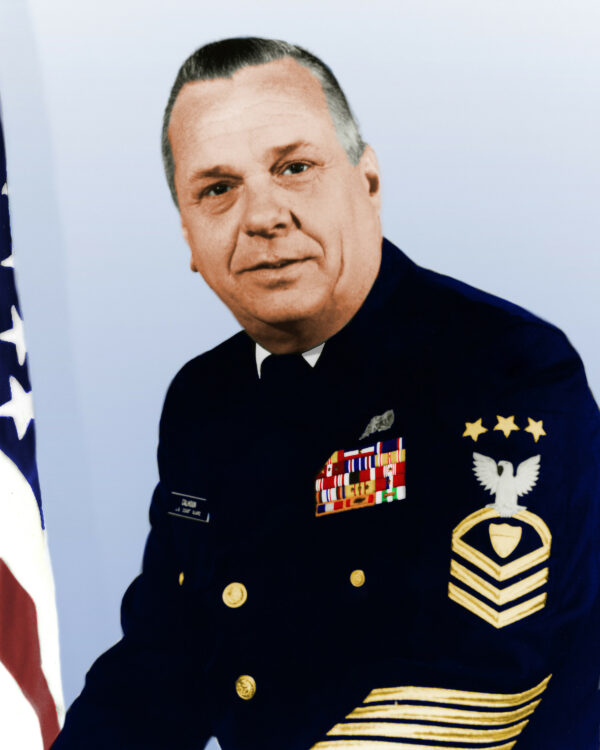
Mary A. Calhoun
As the old saying goes, “behind every good and successful man, stands an exceptional woman,” is evident in the case of Charlie’s principal advisor, financier, authoritarian, companion and keeper of the family, his loving wife, Mary Alyce. Mary’s role throughout Charlie’s 30-year career and beyond was nothing short of superlative. In addition, she forged the role as the Coast Guard’s first ambassador of the voice for families of enlisted members. She stood by Charlie from day one through his departure, never leaving his side. If there’s one thing that can be said of Charlie’s success in life, it has to be summed up with the name, ‘Mary Alyce Calhoun.’
Completing the ‘First Watch’
On August 1, 1973, Master Chief Charles L. Calhoun ‘stood down’ his ‘watch,’ being relieved by Master Chief Yeoman Phil Smith in the position as the Master Chief Petty Officer of the Coast Guard. Charlie retired with over 30 years of combined active service with the Navy and Coast Guard, 14 of those years served at sea. For his service to the enlisted members of the Coast Guard, Admiral Bender presented Calhoun with one of the military’s highest awards for recognition of faithful and dedicated service, the Legion of Merit.
When asked to sum up his best and worst memories of his watch, Charlie remembered the day he was selected as one of his favorites. He also recalled the many laughs he shared with crewmembers at their units and the chiefs’ messes throughout his many travels around the world. On the opposite side, he vividly remembered the stressful times when he often felt overwhelmed by the workload and full schedule. Although his one-man staff of Bill Timmons, then later, Harold Cathey did an outstanding job of keeping his office running, the phone calls and written correspondence never ended. Somehow, he felt that though it was a negative, the positive side was, the workload justified the reason why he was in the position.
Charlie lived by the motto, “Never Give Up!” His philosophy was, “You should have important goals in your life and make every effort possible to obtain those goals. Set your goals high. Believe in being the best in everything you want to accomplish.” Today, I stand before you as a living example of his motto, having set my own personal goals to achieve this position after seeing his picture just two weeks into the Coast Guard, while in recruit training.
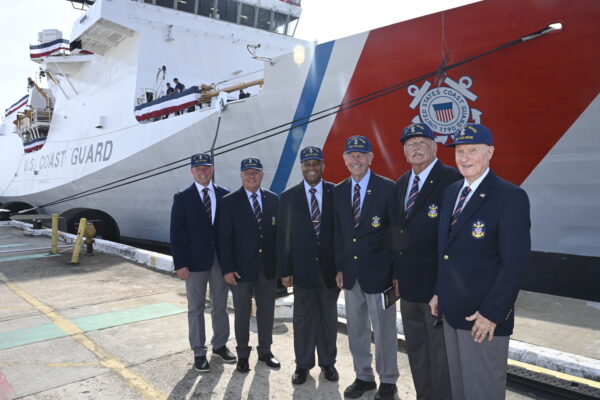
Charlie’s motto would be repeated over and over again, as he worked to bring about positive change to the organization, and being a catalyst to moving forward, making the Coast Guard’s future, prosperous, and protecting the rich legacy and heritage that all of us share in the pride of membership. He set the tone for those who would follow. In the eyes of the countless enlisted members Master Chief Calhoun came in contact with, he re-wrote the chain of command. Master Chief Charles Luther Calhoun was indeed the shining example that defined what we call our Coast Guard core values of Honor, Respect, and Devotion to Duty are today.
If we were to have a visual image of Charlie on the day he departed the living to his final transfer assignment, he would salute St. Peter as he crossed the brow at heaven’s gate, requesting permission to come aboard. With an enthusiastic reply, St. Peter would proudly say, “Welcome aboard shipmate, you have made the world a better place. You’ve touched the lives of many who today emulate you as a stellar performer and a modeled human being. You’ve done good!”
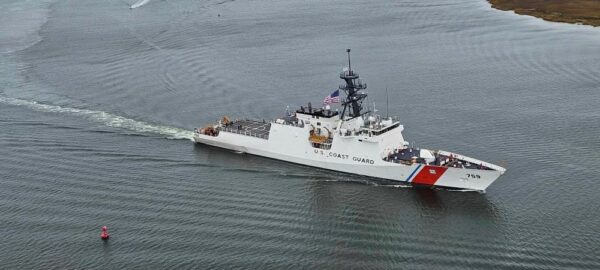
National Coast Guard Museum insider tip: Visitors will have the opportunity to learn more about Master Chief Calhoun, including artifacts from his time in service, in the Evolving Defense Roles exhibit on Deck03 of the National Coast Guard Museum!
